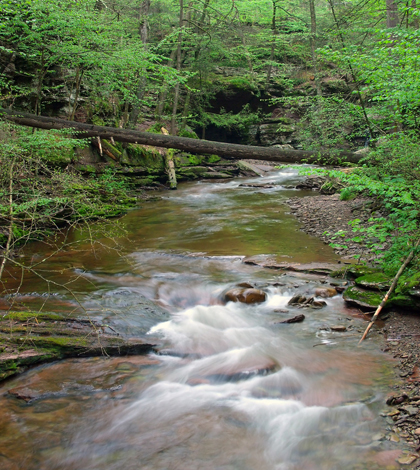Pennsylvania streamflow estimator delivers years of data on ungauged streams

More than 300 gauges across Pennsylvania continuously monitor how much water flows through many of the state’s rivers and streams, providing crucial data for water managers, regulators and researchers. But with tens of thousands of miles of streams across the state, plenty go ungauged.
“We do have really good coverage, but there’s no way that you can monitor streamflow at all of the streams in the state,” said Marla Stuckey, assistant director of the U.S. Geological Survey Pennsylvania Water Science Center. “We do a pretty good job of having stream gauges on the larger rivers, but when you get down into the smaller tributaries it’s just really impractical to have a stream gauge on all of those watersheds.”
Streamflow statistics are important for regulatory purposes like evaluating whether a water withdrawal project will harm a nearby stream by removing too much water from the system. For those cases when data from a gauge isn’t available, a new tool from the USGS generates nearly 50 years’ worth of estimated baseline daily streamflow measurements at sites in Pennsylvania where gauges have never been installed.
Though there are other common methods for generating streamflow statistics at ungauged sites, they can’t deliver estimations of daily flow over a long period of time. The USGS tool, called the Baseline Streamflow Estimator (BaSE for short), produces a mean streamflow estimate at any site for each day from 1960 to 2008.
Pennsylvania is among the first states with this kind of tool.
“This is a new methodology to be able to obtain the daily values that allow the water managers run different statistics, to be able to evaluate the streamflow within these ungauged watersheds,” said Stuckey, who helped develop the tool.
The BaSE program, available for download from the USGS, derives its streamflow estimates from the records of around 160 reference gauges across the region. After the user enters basin characteristics for an ungauged location, the program drills down through maps of all the reference gauge basins. Once it determines which reference site is best correlated with the ungauged site, another round of number crunching delivers a new set of daily streamflow estimates.
The state’s Department of Environmental Protection, the Susquehanna River Basin Commission and The Nature Conservancy helped fund the tool’s development, which took around two years. There was particular interest in the state for helping water managers and regulators define how much water is needed in streams to sustain ecology, Stuckey said.
“We’ve been getting good feedback about this,” she said. “It seems like people are pretty excited. I think there are a number of different applications that we aren’t even thinking about.”
One of those applications depends on the tool’s ability to select a reference gauge. Managers commonly rely on gauges on nearby streams to give an indication of what’s going on in at unmonitored sites. BaSE gives them a scientific method for selecting the best reference.
“It’s nice having a consistent approach to defining a reference gauge, and one that can be replicated over and over again by anyone,” Stuckey said. “It takes the subjectivity out of it.”
Image: Kitchen Creek in Pennsylvania (Credit: Nicholas A. Tonelli, via Flickr)




0 comments